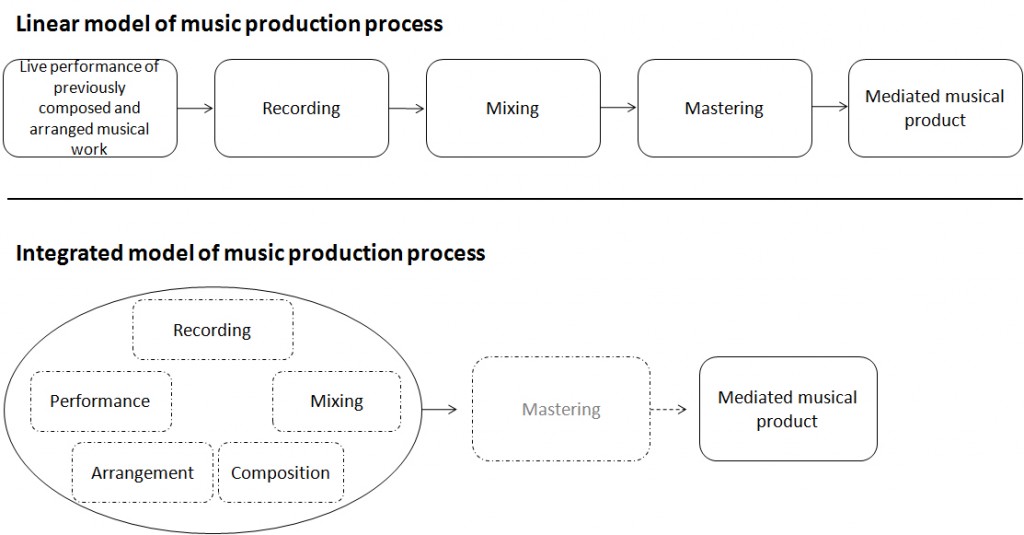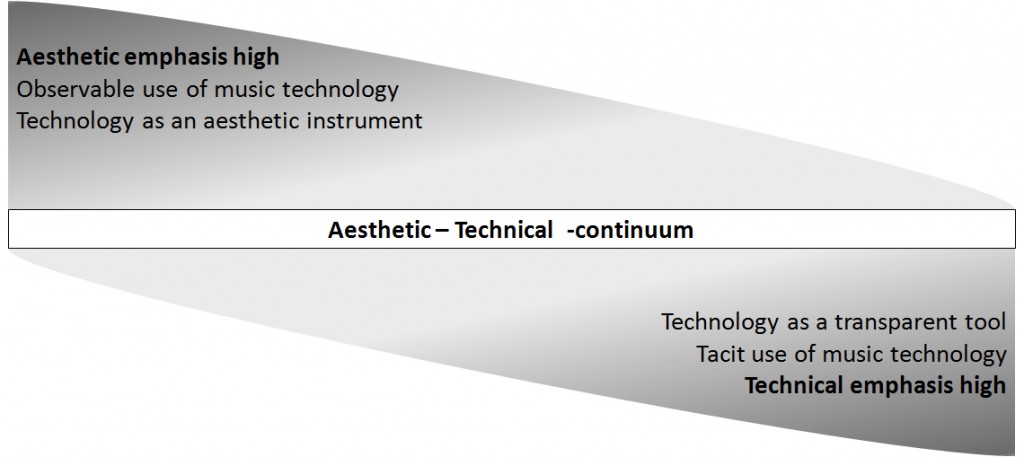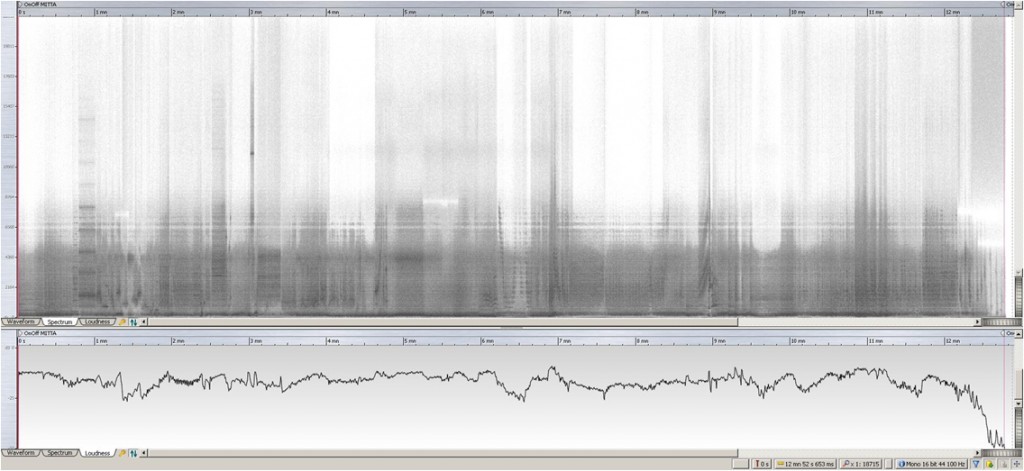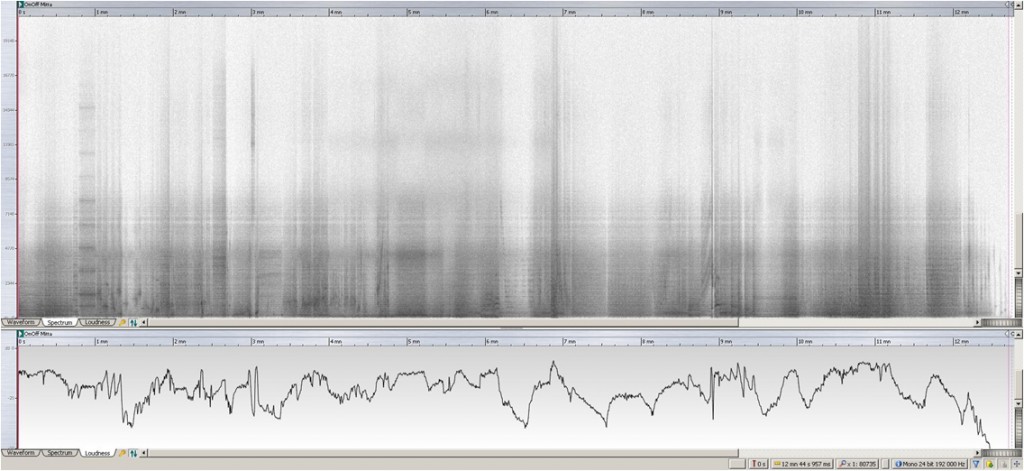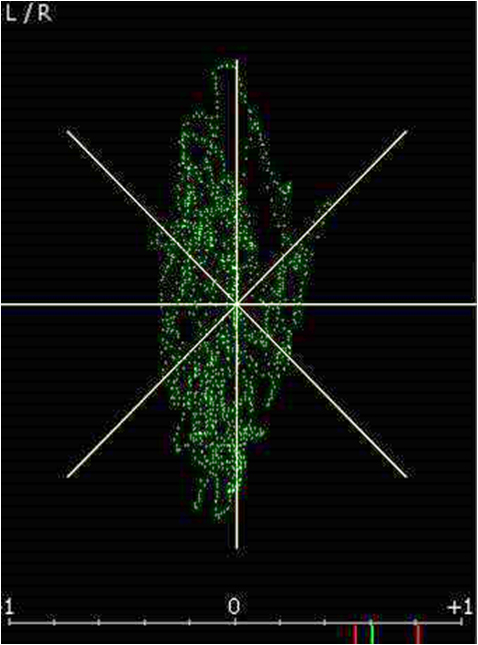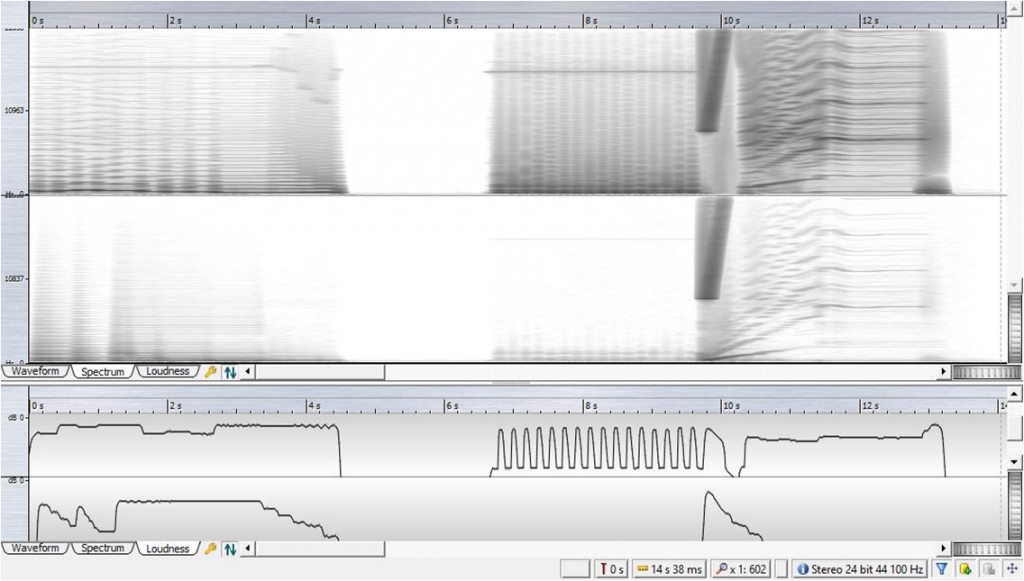Introduction
The focus of this paper is two-fold. On the one hand, I am outlining the details affecting the stance that an audio engineer adopts towards music technology during sound processing. On the other, I describe the relationship between a work of electroacoustic tape music and its medium – mainly in the analog domain, i.e. the magnetic tape. These two main topics are derived from the examples encountered during the audio mastering process of the recordings by the Finnish electroacoustic music composer and instrument designer Erkki Kurenniemi (b. 1941), which resulted in ten of his works, recorded between 1963 and 1975, being released on the album Rules (2012, Ektro / Full Contact Records, KRYPT-022).
A musical work realised on a physical medium such as magnetic tape has a certain relationship to this medium. Although, the physicality should be secondary and the primary attention should be paid to the sonic output, the medium has features that can significantly affect the interpretation of the work in several ways. The audio mastering process – in its broad definition including digitization, restoration and sound processing in general – therefore has the capacity to direct the analysis of a tape music work. In other words, the audio engineer responsible for the mastering process can alter the sonic identity of the work, and thereby realize a new version upon which subsequent analysis will be based. When comparing the tasks executed first by the composer of the work and later by the mastering engineer, we can see how music technology can be used on two seemingly independent but tightly intertwined levels, which I here describe as aesthetic and technical.
Some of the examples presented here are obvious errors due to careless sound processing during restoration. However, these examples reveal how the mastering engineer can (un)knowingly step into the realm of interpretation. In this respect, his or her role in the process can be likened to that of a musician or a conductor. In such cases, a processed version can be seen as the mastering engineer’s rendition of the work, reflecting the quality of the technology used as well as the aesthetic ideals of the era. This is not unlike Roman Ingarden’s notion of how each epoch interprets musical works in its own way and defines what is correct and what is authentic at the time, according to either the public or the performer (Nattiez 1990, 74). When applying observable sound processing to alter the musical work, the mastering engineer should decide whether he or she aims at enhancing the sonic character of the musical work or at securing the work’s authentic nature created by its original author.
The article is divided into two main sections. In the first part, I review the definition of audio mastering as well as present a general introduction to the historical development of music technology and see how this development has affected the music production processes. In addition, the first part includes the description of the theoretical frameworks – such as the aesthetic-technical continuum and the intrinsic and extrinsic properties of sound recording – which I shall use to conceptualize my Ph.D. research project on technologically-oriented music production and composition processes.
In the second part, I introduce in more detail the examples that have directed the outlining of the aforementioned theoretical frameworks. The audio mastering case study in the second section includes such themes as the digitization and restoration of analog tapes, dynamic processing, channel orientation, noise reduction and equalization, wow and flutter, as well as the specific problems in choosing the suitable versions of the musical works to be issued on an album release.
The role of audio mastering in the music production process
Due to the development of music and sound recording technology, the traditionally linear music production process can be seen to diversify into an integrated process (see Figure 1). Together with this diversification, the overall role of an audio engineer has extended and seems to have become more tightly included in the aesthetic side of the music production process. It is worth noting that during the acoustic era of music production – especially in direct-to-disc recording – recording, mixing and mastering were effectively integrated into a single task. The linear model is therefore applicable from the electric era onwards. A detailed description of the development of music production and the different roles of an audio engineer in this development has been aptly presented, for example, by Burgess (2014, 16–65).
Figure 1. The traditional linear and the more recent integrated music production processes.
In the linear process, the audio engineer’s expertise emphasizes the technical handling of recording technology, whereas the aesthetic emphasis is on the well-rehearsed performance of a previously composed and arranged musical work. Gradually, in keeping with the development of music technology, the audio engineer gained the status of an artistic agent and the studio became a tool for aesthetic expression in itself. In certain productions, the individual tasks – such as composition, arrangement, performance, and recording or mixing – can occur simultaneously and are impossible to distinguish from one another. A thorough description of this transition is presented, for example, by Schmidt-Horning (2013). This development is reflected more or less directly in audio mastering as well. In the most extreme scenario, in the era of digital media files and easy online access, the separate mastering process executed by a dedicated professional can be bypassed altogether.
According to the definitions of several engineers, audio mastering can be described as the last step in the music production process before replicating and distributing the final musical product to the consumers (e.g. Bassal 2002, 3; Katz 2007, 12; Cousins and Hepworth-Sawyer 2013, 1; Waddel 2013, 1). The essential and perhaps the most important purpose of the mastering process throughout its existence has been to ensure that the musical product translates into various reproduction systems and that the product is distributed in formats compatible with various media and technologies. It is unclear when the term mastering first appeared, although the introduction of audio mastering as a distinct process has been linked with the emergence of the tape recorder (Bassal 2002, 9; see also Burgess 2014, 49). Prior to magnetic tape recording, tasks similar to those of a mastering engineer were handled, for example, by a disc-cutting or transcription engineer. The specific techniques and methods applied in the mastering process have obviously changed together with the development of music technology. However, it can be argued that, in general, its role has changed only a little.
I refer here to the audio mastering process in its broad sense and use it as a term that includes all tasks that can be performed on a musical product in this last step before replication and distribution; in other words, audio mastering here includes digitization, restoration, conservation and remastering. The terms restoration and remastering can be used almost interchangeably. The term remastering emphasizes a new processing of previously released sound recordings, whereas restoration can refer to the processing of archived but not previously released recordings. From a technical viewpoint, these processes differ only a little, and in a broad sense can be regarded as manifestations of the same process. However, especially in the remastering and restoration process, the question of whether to preserve or enhance the original recording has to be given close consideration. In many remastering projects, the enhancement of the audio quality of a recording can be the primary goal, for example, when a record label is aiming at releasing a new version of an old recording with enhanced sound quality.
It has been taken into consideration here that the objectives of an audio restoration process differ from those pursued in audio mastering for a commercial record release. Furthermore, the audio mastering of electroacoustic music differs slightly from the mastering process of other types of music. Nevertheless, both of these processes employ similar audio equipment and sound processing techniques. Thus, the general description presented in this paper is applicable to the audio mastering of different musical genres. In addition, I suggest that the stance that an audio engineer takes towards music technology can be outlined with one conceptual framework, despite the aforementioned differences.
The audio engineer’s stance towards technology
The aforementioned division into the linear and integrated processes forms the basis for describing the use of technological artefacts with the concepts of the aesthetic and the technical. Despite this tighter inclusion of an audio engineer into the aesthetic side of the music production process, the tacit technical handling of technology hasn’t entirely vanished. For example, the mastering process may consist of the confirmation that the final mixes are ready for distribution as is or with only minor and unobservable sound processing, as well as the handling of technical details essential to the mastering process such as producing PQ sheets and inserting ISRC codes, among other tasks – in other words, the process includes no aesthetic activity, but only the technical handling of music technology.
It is worth noting that these concepts do not form a dichotomy, but a continuum (see Figure 2) on which the engineer using music technology can locate himself or herself. The apparent dualism here is only a theoretical and analytical tool aimed at a thorough description of the use of music technology. I otherwise agree with Frith and Zagorski-Thomas (2012, 3) that the aesthetic and technical orientations are inseparable from one another, and that in studio work, decisions based on either aesthetic or technical judgment are intertwined and affect each other quite seamlessly.
Figure 2. Aesthetic–Technical continuum where the engineer using technology can locate himself or herself.
An audio engineer applying aesthetic sound processing to seek new artistic expressions could locate himself or herself at the far left end of the continuum. There, the observable use of music technology is emphasized, while the textbook handling of music technological devices can be almost non-existent – a typical example being a process where technological artefacts are used contrary to their initial purpose, or even severely abused. The classic examples here would be the extreme use of auto-tune effect for producing a robot-like vocal behaviour, or overdriving audio equipment to achieve various distortion effects. Furthermore, in the acousmatic concert environment, the audio engineer responsible for the sound diffusion of the music is usually permitted to enhance and even modify the nature of the musical work to a great extent. On the other hand, sound processing, which could be located at the far right end of the continuum, concentrates on using technology in a subtle and unobservable manner. This attitude towards the use of technology is clearly dominant in classical concert recording projects or among hi-fi enthusiasts interested in high-quality sound reproduction systems.
The far right end of the continuum is related to the controversial concept of transparency, which has generally been used to describe how music technology should not produce any audible or aesthetic alteration of the musical performance – neither on record nor in live performance circumstances (e.g. Théberge 2001, 3). It should be noted that the transparent use of technology is not in contradiction to its creative use; to some extent, a recording is always an illusion of the real world, and the transparent use of technology rarely aims at the perfect replication of our surrounding reality. With the development of music technology, a new kind of reality has emerged – the reality of recorded music. Recorded music is expected to sound like something that is directed, for example, by the criteria of the musical genre in question. The objective of an engineer located at the far right end of the continuum is to guarantee the immersive experience of the listener, who should be entirely absorbed into the musical performance, while the reproduction technology is dissipated – i.e. the technology is transparent.
The mastering engineer’s attitude towards the use of technology can also be located on the continuum of Figure 2. The mastering engineer, located at the far right end of the continuum, is most likely concentrating on respecting the sonic characteristics of the final mixes. Meanwhile, in the remastering or restoration processes, adopting a transparent stance towards technology is respecting the original version of the musical work and aiming at restoring its initial nature. Copeland (2008, 316), for example, reminds us that the sound archivist’s responsibility is to “preserve the original intended sound”; that is, to locate himself or herself at the far right end of the aesthetic–technical continuum. Moving towards the left end allows the mastering engineer to enter into the realm of interpretation and to alter the musical work more freely to meet the sound ideals and standards that differ from those contemporaneous with the work. The far left end of the continuum might be entirely theoretical in the context of audio mastering; however, one can also find highly experimental and artistic mastering processes, for example where sound files are processed using image editing software, resulting in a totally chaotic and distorted outcome.
The intrinsic and extrinsic properties of sound recordings
Along with the features of technological artefacts that are deliberately designed for a certain purpose, musical devices have properties that are unknown and can play tricks on their users. These properties can be heard as “the sounds of the medium” during playback. Especially in the remastering and restoration processes, the mastering engineer is faced with a process of distinguishing these sounds from the sounds of the actual music. In most cases, the process doesn’t cause any significant problem, but in certain genres of electroacoustic and popular electronic music this raises interesting questions. In these types of music, the timbre of the sonic output bears a pivotal musical meaning, and thus is equally important with the other, more traditional musical features.
The sound gestures perceived during the reproduction of recorded music can be defined as the intrinsic or extrinsic properties of the sonic output of the recording. During playback, the audio engineer decides whether the perceived sound gesture carries meaning intrinsic to the musical work or not. Sounds that are related to the recording medium are extrinsic to the musical work. Based on this decision, the engineer employs sound processing means to alter the sonic output to meet the desired criteria. Typically, this processing is aimed at enhancing the clarity of the recording by removing unwanted noise, clicks and crackle; however, on some occasions the processing may also affect the intrinsic properties which carry musical meaning, as will be demonstrated in the following case study.
Case study: The mastering process of Erkki Kurenniemi’s tape archive
Instrument designer and composer Erkki Kurenniemi was a central figure of the Finnish electroacoustic and experimental music scene in the 1960s and 1970s. Between 1962 and 1975, Kurenniemi designed ten unique electronic musical instruments and studio devices. Between 1962 and 1980 he completed approximately thirty works of electronic music. These include independent tape music pieces, as well as music and sound effects for films, exhibitions, happenings, theater and radio plays. Some of his works were initially instrument tests, and only after being released on an album gained the status of a musical work. Kurenniemi’s straightforward, improvised and technologically oriented music has challenged the traditional concept of a musical work, and even drawn enthusiastic statements against its musical value. For more information on Kurenniemi’s musical works and instruments see, e.g., Lassfolk (2012; 2013), Ojanen & Lassfolk (2012), Ojanen et al. (2007) and Suominen (2013).
Kurenniemi’s music production remained fairly unknown until 2002, when the Finnish Love Records company released the CD Äänityksiä/Recordings 1963–1973 (LXCD637), compiled by film director Mika Taanila. In the same year the Kiasma Museum of Contemporary Art released the CD On/Off (NYK-001) as an attachment to a book by musicologist and sound artist Petri Kuljuntausta (2002). Prior to these compilations only such works as Dance of the Anthropoids (1968) and Inventio-Outventio (1970) were available on record. These were rare collector’s items: the 100th anniversary record of the Student Union of the University of Helsinki, Perspectives ’68 – Music in Finland (1968), and Kurenniemi’s own promotional 7” single Dimi is born (1970). A one-minute excerpt from Dance of the Anthropoids was released on the album Tombstone valentine (1970; Love Records LRLP19) by the Finnish progressive group Wigwam. With the release of Rules, Kurenniemi’s music catalog is almost fully available on the commercial record market. The list of Kurenniemi’s musical works is complete, although the ongoing digitization process of his old tape archive occasionally reveals interesting tapes of materials, instrument demonstrations, and improvisations.
Digitization processes of Kurenniemi’s audio tapes
Kurenniemi’s tapes have been digitized at intervals of about ten years. In the early 1990s, composer Jukka Ruohomäki conducted an extensive digitization process of approximately six hundred Finnish electroacoustic musical works and other recordings. Ruohomäki’s project was stored on DAT tapes in the archive of the Finnish Music Information Center. This collection was later transferred to CD-R discs and AIFF sound files. In 1999, musicologist Petri Kuljuntausta started a research project on the history of early electronic music in Finland. As part of this project, Kuljuntausta digitized electronic works from the 1950s and the 1960s, including Kurenniemi’s works. Kuljuntausta (2008, 322–324) describes his digitization and mastering process in his Ph.D. dissertation First Wave. After I was commissioned to compile an album of Kurenniemi’s music, I made – together with Dr. Kai Lassfolk – new digitizations of Kurenniemi’s original master tapes in the University of Helsinki Electronic Music Studio during March and April 2012.
Although the overall setup of Kurenniemi’s original studio is fairly well known, it is impossible to restore the exact equipment and connections he used when producing his musical works.
Although Kurenniemi likely used the Studer C-37 – still available in the University studio – as his master recorder, we chose to use a Revox PR-99 as the playback device, because of its current better condition. The signal chain used in the digitization process of Kurenniemi’s tapes for the Rules album is illustrated in Figure 3.
Figure 3. Digitization setup of Kurenniemi’s master tapes in 2012.
Analysis of the Rules mastering processes
The mastering process of the Rules album revealed interesting details of the relationship between music and technology. These details are exemplified in the following case study. Most of these examples are derived from the comparison of different versions of Kurenniemi’s first electroacoustic work On-Off (1963) (see Figure 4). In addition to our recent digitization, at least three different versions of the work were available for inclusion on a record release. These include the version made by Ruohomäki in 1992 (the highest track in Figure 4), the only commercially released version mastered by Kuljuntausta in 2002 (the second track from the top), and the unreleased second generation listening copy included in the compilation tape of Finnish electroacoustic music archived at the University of Helsinki Electronic Music Studio (the bottom track in Figure 4). Although the work was copied in the 1980s using the wrong tape speed by mistake, the same musical structure can be detected even in this version. However, the work has been shrunk in half time-wise and its pitch has been doubled.
Figure 4. An overview of the four versions of On-Off.
The amplitude images above give a rough estimation of dynamic differences between different versions of the work. On the first track, the digitized version from 1992; on the second track, the only released version from 2002; on the third track, the recent digitization from 2012, and on the bottom track, the double-speed version from the compilation tape from the 1980s.
Dynamic processing
On-Off has been described as a static wall of noise with little dynamic variation (see Lassfolk 2012, 60). When listening to the two CD releases of the work from 2002, this is a valid interpretation. However, the observable sonic output of these releases appears to be in contradiction to the concert reviews of the work from the 1980s. Salonen (1980 in Kuljuntausta 2002, 391), for example, described the work as “quite boring with endless noise and slow wedge-like forms” and Lampila (1980 in Kuljuntausta 2002, 391) ”— at its most suggestive moments [noise] pierces the ear”. It seems that these reviews report at least some degree of dynamic behaviour, whereas the interpretation of the version released in 2002 directs the analysis in a different direction. This can be partly explained by comparing the dynamics of the three digitized versions (see Table 1). It is noteworthy that the later analysis, which is based on the new digitization, has changed the interpretation of the sonic character of the work (see Lassfolk 2013, 6).
Table 1. Dynamic comparison of three versions of On-Off.
Reading the rough figures from the -2 dBFS peak normalized versions, the 1992 and 2012 versions have approximately 20 dB wider dynamic ranges than the one used on the album releases of 2002. According to Kuljuntausta (2008, 322–324), the compression was done intentionally to improve the dynamics of the work. The alteration of the dynamic range is clearly visible in the spectrograms and loudness contours of the versions (see Figures 5a, 5b and 5c). (The spectrogram images and loudness contours are produced using Steinberg Wavelab 7.0 mastering software. The visible dynamic range in the loudness contour images is approximately 50–70 dB, depending on the image.)
Figure 5a. The spectrogram and loudness contour of the 1992 version of On-Off.
Figure 5b. The spectrogram and loudness contour of the 2002 version of On-Off.
Figure 5c. The spectrogram and loudness contour of the 2012 version of On-Off.
Channel orientation
When processing the analog tapes attention should already be paid to the channel count and type in the digitization phase. In Kurenniemi’s works there are three types of audio channel orientation: mono (full-track), dual mono (two half-tracks) and stereo. The fact that the Revox PR-99, used in the digitization process, is a ¼” two-track recorder, and some of Kurenniemi’s original master tapes are ¼” full-track tapes, causes issues which have to be taken into consideration during the process. Firstly, according to Copeland (2008, 180), for example, the signal-to-noise ratio is about 4.5 dB worse when playing a full-track tape with a half-track recorder, if compared with playing the tape with an appropriate machine.
Secondly, the difference between the dual mono and stereo configurations should be noticed. In the works that are laid down on two channels, the stereo field usually remains coherent throughout the work. In some of Kurenniemi’s musical works – especially in the tape collages – the sonic content occasionally varies between dual mono and stereo. By this, I refer to the situation where the original full-track material tape is re-recorded to only one channel of the two-channel master tape. The difference between the dual mono and stereo track is that on a stereo track the sound material – even though it might be a point-source signal – can be located anywhere in the stereo field, whereas the sound material occupying only one channel of two half-tracks is incapable of moving in the stereo field and appears as hard-panned on the one side of the stereo image.
In addition to the aforementioned problems with the incompatibility of tape recorders’ channel orientations, playing the full-track tape with a two-track tape recorder can cause an effect that I refer to here as pseudo-stereo. The sonic output of a tape-work that is originally recorded as full-track is mono. A full-track mono channel is incapable of producing any observable movement in the stereo field, even when reproduced on a two-channel speaker system. If the speaker balance is correct and the speaker location in a listening room is symmetrical, the mono audio signal appears to be stationary in the middle of the phantom image of the two speakers.
The master tape of On-Off is a full-track recording; to authentically preserve the work’s nature it should be reproduced on a full-track tape recorder. As the appropriate machine was not available, the digitization was made using a two-track tape recorder. When the master tape of On-Off is played back with a stereo configuration, an observable pseudo-stereo effect appears due to an unbalanced reproduction of the left and right sides of the tape. This can be due to different reasons. The tape can be worn out unevenly, or the alignment of the tape recorder’s playback head might be incorrect. The pseudo-stereo effect can be visualized with an audio goniometer and a phase meter (see Figure 6).
Figure 6. A goniometer and phase meter showing the phase difference between left and right channels in the beginning of the version of On-Off released in 2002.
If the original tape is played on a two-track tape recorder, only one channel should be used in the reproduction of the work in order to overcome the pseudo-stereo problem. On the former releases of On-Off (the CD as an attachment of the On/Off book by Kuljuntausta, and Äänityksiä/Recordings 1963–1973), a stereo file was used, and thus these releases reproduce the pseudo-stereo version of the work. For the Rules album, only the right channel of the digitized audio file was used, in order to preserve the original nature of the work.
Noise reduction and equalization
In terms of musical genre, On-Off can be categorized as noise. Its sonic character is dominated by a wide spectrum of noise and the distinctive sound of a distorted spring reverb unit. The original sound sources of the work are processed beyond recognition by overdriving the studio equipment. Even the detection of the tape hiss from the noise of the work is difficult. As a result, deciding whether a certain sonic character is an intrinsic property of the work or related to the magnetic tape poses a problem.
Comparison of the last thirty seconds of different versions of On-Off reveals how the noise reduction and equalization can produce new sound gestures and alter the sonic characteristic of the work. The slow wedge-like ending of the work reveals the static background noise wall, which is presumably produced by the recording medium (see Figures 7a and 7b). In the 2002 version, the noise reduction plug-in produces a new sonic gesture. When the overall loudness of the work is diminished, the noise reduction plug-in deactivates and the tape hiss emerges – during two seconds (position approx. 12 min 20 s in this example; see Figure 7a). The new sonic gesture is clearly audible in the 2002 version. In the unprocessed version, the static background noise is recognized as tape hiss, but in the processed version the modulation of the background noise might be interpreted as part of the work.
Figure 7a. The ending of the 2002 version of On-Off.
 Figure 7b. The ending of an unprocessed 2012 version of On-Off.
Figure 7b. The ending of an unprocessed 2012 version of On-Off.
In addition to the noise reduction, two narrow equalized bands are visible in the spectrogram. This overall equalization also has its effect on the work, and the altered version has a distinctively different sonic character.
Wow and flutter
In some cases, over the decades, the adhesive tape that has been used to splice pieces of the audiotape together has lost its flexibility. When the stiff tape passes the pinch roller of the tape recorder, it can produce an audible wow effect on the output. Depending on the sonic material of the work this can be accidentally interpreted as an intrinsic musical property of the work. An example of this was noticed in the work Saharan uni I (1967), whose drone-like synthesized chords include glissandi. The audible wow effect is visible in the spectrogram (see Figure 8a). A restoration was made in the analog domain by replacing the old adhesive tape with a new one. This mended the problem and the wow effect didn’t appear in the later playback sessions (see Figure 8b).
Figure 8a. The wow effect in Saharan Uni I.
 Figure 8b. The restored version of Saharan Uni I.
Figure 8b. The restored version of Saharan Uni I.
Additional problems
The lack of reference tones and proper leader tapes in Kurenniemi’s masters can cause further confusion. It is likely that the aforementioned tape speed problem (see the bottom track in Figure 4) would have been avoided if a reference tone and the proper leader tape indicating the correct playback speed had been included at the beginning of the master tape. The fine-tuning of the original tape speed is impossible without appropriate reference tones. Its effect on the length of the works is trivial – excluding the aforementioned double-speed example – but even a minor variation in the tape speed can have a significant, perceivable effect on the overall pitch of the work. The lack of the leader tape can also cause confusion regarding whether the tape is reeled head or tail out. In some cases, when listening to electroacoustic or experimental music, the correct direction of the tape is impossible to judge from the sonic output.
Choosing the version to be used on an album release
When compiling the Rules album, the versions to be issued on the release could have been chosen from the different versions already available. In the case of On-Off one option would have been the monophonic version stored in the archive of the Finnish Music Information Center (i.e. the 1992 digitized version in Figure 5a). The closer examination of the AIFF file revealed that the work included several audible snaps. These possibly digital dropouts are visible also in the spectrogram of the work (see Figure 9). However, the original DAT tapes have been destroyed, and so the exact source of the errors can’t be traced.
Figure 9. Digital dropouts – the vertical grey bars that appear periodically across the frequency range – in the 1992 version of On-Off (a detail of Figure 5a).
The compilation album Äänityksiä/Recordings 1963–1973 (2002), in turn, includes a version of the work Inventio-Outventio (1970) that was digitized from the original vinyl record Dimi is born (1970). Comparison of this release with the 2012 digitization used on the Rules album reveals differences in both sound quality and channel arrangement. The 2002 version includes several crackles and snaps typical of the vinyl medium. These are both audible and visible (see Figures 10a and 10b). The comparison of Figures 10a and 10b also illustrates that the channel orientation of the original vinyl, and thus also in the 2002 CD release, is different from the original master tape. Furthermore, there is either a leakage between the audio channels, or the channels of the original dual mono master tape haven’t been hard-panned during the mastering of the original vinyl single.
Figure 10a. The 2002 released CD version of Inventio-Outventio is copied from the original vinyl single – including audible snaps and leakage between the channels (14 sec. excerpt from the middle section of the work). The channel orientation also differs from the original master tape (see Figure 10b).
Figure 10b. The 2012 digitization of the Inventio-Outventio master tape (14 sec. excerpt from the middle section of the work).
Conclusions
With the aforementioned examples, I have studied how a work of electroacoustic music is in a close relationship with its medium. According to this scrutiny, it can be argued that, in certain genres of electroacoustic and electronic popular music, the recording medium’s ability to produce sound gestures extrinsic to the musical work can pose problems during the audio mastering process. Whether an audio engineer mistakenly interprets these extrinsic sound gestures as the intrinsic properties of the musical work, or correctly as extrinsic properties related to the recording technology, is dependent on his or her abilities to accurately distinguish these gestures from the actual musical material. The study of the mastering engineer’s decision-making process shows how technology can be used on at least two seemingly independent but tightly intertwined levels: the aesthetic and the technical. The examples above show how sound processing during audio mastering can alter the sonic character of the musical work and even direct its analysis.
However, when consciously and justifiably applied, the mastering engineer can use technology to enhance and alter the sonic output of a recording. This raises an interesting issue of technological development and aesthetics in relation with time. The sound ideal and the quality of technology have changed over the years. The mastering engineer’s role can be interpreted as the updating of the musical work to meet the standards of today. In this respect, the alteration of a musical work is not unlike the different interpretations of a musical work at different times. Here, for example, the dynamic processing of the 2002 version of On-Off can be interpreted as reflecting the present-day “loudness war” trend.
Acknowledgements
The author wishes to thank Dr. Kai Lassfolk for his expertise and valuable help in the digitization process of Kurenniemi’s master tapes; the audience at the 9th Art of Record Production Conference in Oslo (December, 2014) for their inspiring comments and conversation; Mr. James Andean and the peer reviewers for their highly helpful and excellent revision suggestions.
Bibliography
Bassal, D. (2002) ‘The Practice of Mastering in Electroacoustics’. In eContact! 6.3. [Online]. Available at: http://cec.sonus.ca/pdf/The_Practice_of_Mastering.pdf
(Accessed: February 2015).
Burgess, Richard James (2014). The History of Music Production. Oxford: Oxford University Press.
Copeland, P. (2008) Manual of Analogue Sound Restoration Techniques. London: The British Library. [Online]. Available at: http://www.bl.uk/reshelp/findhelprestype/sound/anaudio/analoguesoundrestoration.pdf (Accessed: February 2015).
Cousins, M. & Hepworth-Sawyer, R. (2013) Practical Mastering: A Guide to Mastering in the Modern Studio. New York: Focal Press.
Frith, S. & Zagorski-Thomas, S. (2012) ‘Introduction’. In Frith, S. & Zagorski-Thomas, S. (eds.) The Art of Record Production: An Introductory Reader for a New Academic Field. Burlington: Ashgate, pp. 1-9.
Katz, B. (2007) Mastering Audio: the Art and the Science. Amsterdam: Focal Press.
Kuljuntausta, P. (2002) On/Off: Eetteriäänistä Sähkömusiikkiin. Helsinki: Like.
Kuljuntausta, P. (2008) First Wave: a Microhistory of Early Finnish Electronic Music. Helsinki: Like.
Lassfolk, K. (2012) ’Erkki Kurenniemen elektroakustisten sävellysten sointimaailma.’ In A.-E. Pääkkölä (ed.) Suomen Musiikkitiede 100 Vuotta: Juhlasymposiumin Satoa: Finnish Music Research 100 Years: Proceedings of the Celebrational Symposium. Helsinki: Suomen musiikkitieteellinen seura, pp. 58-65.
Lassfolk, K. (2013) ‘The Electronic Music of Erkki Kurenniemi’. In Mellais, M. (ed.), Erkki Kurenniemi – a Man from the Future. Helsinki: Finnish National Gallery, Central Art Archives. [Online]. Available at: http://www.lahteilla.fi/kurenniemi/julkaisu/Lassfolk.pdf (Accessed: May 2015)
Nattiez, J.-J. (1990) Music and Discourse: Towards a Semiology of Music. Princeton: Princeton University Press.
Ojanen, M. et al. (2007) ‘Design Principles and User Interfaces of Erkki Kurenniemi’s Electronic Musical Instruments of the 1960’s and 1970’s.’ Seventh International Conference on New Interfaces for Musical Expression: NIME 2007, pp. 88-93.
Ojanen, M. & Lassfolk, K. (2012) ‘Material Tape as a Piece of Art: Case Studies of an Inconstant Work-Concept in Erkki Kurenniemi’s Electroacoustic Music.’ Proceedings of the Electroacoustic Music Studies Conference Meaning and Meaningfulness in Electroacoustic Music, Stockholm, June 2012. [Online]. Available at: http://www.ems-network.org/IMG/pdf_EMS12_ojanen_lassfolk.pdf (Accessed: February 2015).
Schmidt-Horning, S. (2013) Chasing Sound: Technology, Culture, and the Art of Studio Recording from Edison to the LP. Baltimore: Johns Hopkins University Press
Suominen, J. (2013) ‘Erkki Kurenniemi’s Electronic Music Instruments of the 1960s and 1970s’. In Mellais, M. (ed.), Erkki Kurenniemi – a Man from the Future. Helsinki: Finnish National Gallery, Central Art Archives. [Online]. Available at: http://www.lahteilla.fi/kurenniemi/julkaisu/Suominen.pdf (Accessed: February 2015)
Théberge, P. (2001) ‘Plugged in: Technology and Popular Music’. In Frith, S., Straw, W. & Street, J. (eds.) The Cambridge Companion to Pop and Rock. Cambridge, UK: Cambridge University Press, pp. 3-25.
Waddel, G. (2013) Complete Audio Mastering: Practical Techniques. New York: McGraw-Hill Education.
Discography
Kurenniemi, E., Äänityksiä/Recordings 1963–1973 [CD] Love Records, LXCD637, 2002.
Kurenniemi, E., Rules. [Double LP] Ektro / Full Contact Records, KRYPT-022, 2012.
Kurenniemi, E. & Ruohomäki, J., Dimi is born [Vinyl single] Musica, DDS-1, 1970.
Various artists, On-Off – From Ether Sounds To Electronic Music [CD] Kiasma Records, NYK-001, 2002.
Various artists, Perspectives ’68 – Music in Finland [LP] Love Records, LRLP 4, 1968.
Wigwam, Tombstone valentine [LP] Love Records, LRLP19, 1970.

